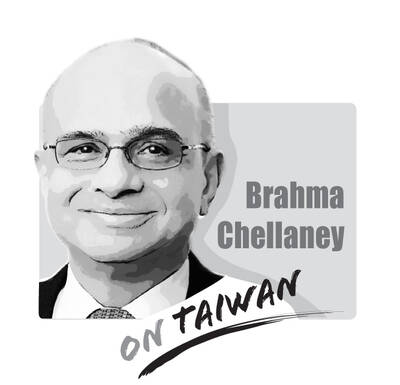Taiwan has experienced dry weather since late last year, meaning that water levels in reservoirs have fallen.
As a result, the Council of Agriculture (COA) has announced that over 40,000 hectares of farmland should be left fallow, and not irrigated, in order to cope with demand for household and industrial water use. The percentage of water usage can be broken down as 20 percent, 70 percent and 10 percent for household, agricultural and industrial use respectively.
Article 19 of the Water Act (水利法) stipulates that, during shortages, the government can place restrictions on industrial and agricultural water usage, while Article 18 specifies household use as the priority, followed by agricultural use then industrial use. Yet whenever there is a drought, it is the agricultural sector that is targeted for cutbacks, violating the water usage priorities set out by the government.
Furthermore, calling for agricultural land to lay fallow has not just happened in periods of drought. In 2002, Taiwan formally became the WTO’s 144th member. To balance domestic supply and demand of rice, agricultural land was made to lay fallow to allow for the import of rice. At one point, the figure was as high as 160,000 hectares — accounting for about 40 percent of the nation’s rice paddies and 20 percent of total agricultural land.
When the COA pushed for land to lay fallow to make way for trade liberalization, it did not clearly define the rice production sector, nor specify its goals. It just announced that rice was the nation’s primary food product, encapsulating a range of issues including food security, economic development in farming communities, social stability, environmental conservation and cultural transmission, and that for this reason it was of paramount importance to maintain an appropriate amount of rice-producing land to ensure food security and maintain sustainable development of the industry.
If one adds the 40,000 hectares of agricultural land that is to lay fallow to other land previously left fallow, the total amount of farmland currently uncultivated is equal to about 50 percent of the available paddy fields, or 25 percent of the total area of the nation’s agricultural land.
Assuming there are no advances in rice production technology, it is difficult to see what advantage the COA envisages in the creeping expansion of the area of agricultural land being made to lay fallow.
Has it learned anything from the experience of laying land fallow in the interests of trade liberalization? Has it found a solution to the wider environmental impact of pests and rodents “encouraged” by laying land fallow? Does it know whether land adjacent to the land being left uncultivated needs to be sprayed with a greater amount of chemicals, pesticides or herbicides as a result?
Has it identified any change in the attitude of those farmers required to stop working their land? Has this had a detrimental effect on the policies of attracting young people to work in the agricultural sector, or of increasing the scale of individual farm operations?
Surely farmers are not sitting around waiting for a COA announcement that farmland should lay fallow, or that all production should be commissioned to other nations in response to changes in the climate, or to comply with the regulations from the latest agricultural agreements, or in response to the many short, mid and long-term factors that the COA does not have any control over.
Wu Pei-ing is a professor in National Taiwan University’s agricultural economics department.
Translated by Paul Cooper

Taiwan stands at the epicenter of a seismic shift that will determine the Indo-Pacific’s future security architecture. Whether deterrence prevails or collapses will reverberate far beyond the Taiwan Strait, fundamentally reshaping global power dynamics. The stakes could not be higher. Today, Taipei confronts an unprecedented convergence of threats from an increasingly muscular China that has intensified its multidimensional pressure campaign. Beijing’s strategy is comprehensive: military intimidation, diplomatic isolation, economic coercion, and sophisticated influence operations designed to fracture Taiwan’s democratic society from within. This challenge is magnified by Taiwan’s internal political divisions, which extend to fundamental questions about the island’s identity and future
Media said that several pan-blue figures — among them former Chinese Nationalist Party (KMT) chairwoman Hung Hsiu-chu (洪秀柱), former KMT legislator Lee De-wei (李德維), former KMT Central Committee member Vincent Hsu (徐正文), New Party Chairman Wu Cheng-tien (吳成典), former New Party legislator Chou chuan (周荃) and New Party Deputy Secretary-General You Chih-pin (游智彬) — yesterday attended the Chinese Communist Party’s (CCP) military parade commemorating the 80th anniversary of the end of World War II. China’s Xinhua news agency reported that foreign leaders were present alongside Chinese President Xi Jinping (習近平), such as Russian President Vladimir Putin, North Korean leader Kim
Taiwan People’s Party (TPP) Chairman Huang Kuo-chang (黃國昌) is expected to be summoned by the Taipei City Police Department after a rally in Taipei on Saturday last week resulted in injuries to eight police officers. The Ministry of the Interior on Sunday said that police had collected evidence of obstruction of public officials and coercion by an estimated 1,000 “disorderly” demonstrators. The rally — led by Huang to mark one year since a raid by Taipei prosecutors on then-TPP chairman and former Taipei mayor Ko Wen-je (柯文哲) — might have contravened the Assembly and Parade Act (集會遊行法), as the organizers had
Minister of Foreign Affairs Lin Chia-lung (林佳龍) last week made a rare visit to the Philippines, which not only deepened bilateral economic ties, but also signaled a diplomatic breakthrough in the face of growing tensions with China. Lin’s trip marks the second-known visit by a Taiwanese foreign minister since Manila and Beijing established diplomatic ties in 1975; then-minister Chang Hsiao-yen (章孝嚴) took a “vacation” in the Philippines in 1997. As Taiwan is one of the Philippines’ top 10 economic partners, Lin visited Manila and other cities to promote the Taiwan-Philippines Economic Corridor, with an eye to connecting it with the Luzon